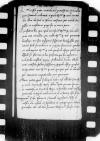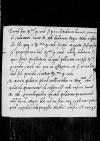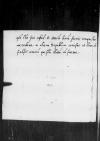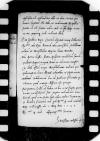Reverendissime in Christo Pater et Domine, domine gratiosissime.
Commendata prona serviendi voluntate in gratiam Reverendissimae Paternitatis Vestrae, ut Dominus Deus illam diu sanam et felicem conservet pro commodo rei publicae et consolatione gregis sui, ex animo precor.
Excusatione hac, qua apud me usa est Reverendissima Paternitas Vestra, mihi potius erat utendu written over a⌈auu written over a⌉m, qui multis Reverendissimae Paternitatis Vestrae provocatus beneficiis, non sine negligentiae suspicione hucusque sileo. Qua ratione facile succumberem, ni e regione succurreret, prudentia et benignitas Reverendissimae Paternitatis Vestrae, qua facile assequi potest, quam difficile sit plurimis in hac praesertim, quae hic agebantur, rerum turba implicitum negotiis scribendarum litterarum, studio tanti antistitis palato satisfacere. Proinde obsecro, ignoscat taciturnitati meae Reverendissima Paternitas Vestra, praecipue cum non aliunde, quam innumeris occupationibus meis proveniat.
Nunc autem, quod scribam, non habeo, nisi oblectet scire Reverendissimam Paternitatem Vestram sacram ⌊regiam maiestatem⌋ dolore ex superinscribed⌈exex superinscribed⌉ optimi ⌊parentis sui⌋ morte concitatam et ⌊senatorum Regni⌋ instantibus cond consiliis provocatam in ⌊Regnum⌋ accelerare et iam in itinere esse, feria quinta [ante] Trinitatis on the margin⌈ante hidden by binding⌈[ante]ante hidden by binding⌉ Trinitatis[ante] Trinitatis on the margin⌉, si Deo placuerit, ⌊Cracoviam written over e⌈eamam written over e⌉⌋ ingressuram. Istic cum consilio omnium ordinum et sepulturae, et ⌊comitiis⌋ operam daturam, praemissus autem est dominus ⌊Ioannes Radziwil⌋, incisor huius
 BCz, 1599, p. 1060
⌊Ducatus⌋, qui ⌊maiestatem reginalem⌋ et praecipuos Regni proceres hidden by binding⌈[es]es hidden by binding⌉ ⌊Cracoviae⌋ praesentes nomine maiestatis suae regiae consoletur mentemque hidden by binding⌈[emque]emque hidden by binding⌉ illorum, quae agenda super his, perquirat. Cubicularii e[...] hidden by binding⌈[...][...] hidden by binding⌉ ad alios absentes missi sunt cum litteris, etiam pro consilio, ut hidden by binding⌈[ut]ut hidden by binding⌉ diem sepulturae et ⌊comitiorum⌋ deliberent et ⌊maiestati suae⌋ s[...] hidden by binding⌈[...][...] hidden by binding⌉ficent.
BCz, 1599, p. 1060
⌊Ducatus⌋, qui ⌊maiestatem reginalem⌋ et praecipuos Regni proceres hidden by binding⌈[es]es hidden by binding⌉ ⌊Cracoviae⌋ praesentes nomine maiestatis suae regiae consoletur mentemque hidden by binding⌈[emque]emque hidden by binding⌉ illorum, quae agenda super his, perquirat. Cubicularii e[...] hidden by binding⌈[...][...] hidden by binding⌉ ad alios absentes missi sunt cum litteris, etiam pro consilio, ut hidden by binding⌈[ut]ut hidden by binding⌉ diem sepulturae et ⌊comitiorum⌋ deliberent et ⌊maiestati suae⌋ s[...] hidden by binding⌈[...][...] hidden by binding⌉ficent.
De nuptiis vero iuxta desiderium Reverendissimae Paternitatis Vestrae quid p[...] hidden by binding⌈[...][...] hidden by binding⌉ficem, nescio. An enim hic actus nuptiarum nomen merue hidden by binding⌈[rue]rue hidden by binding⌉rit, cum musica in luctu importuna sit, narratio apud hidden by binding⌈[pud]pud hidden by binding⌉ me incertum est. Hoc tamen in confesso est, quod iam ad hidden by binding⌈[d]d hidden by binding⌉ aures Reverendissimae Paternitatis Vestrae pervenisse non dubito, ipsam illu hidden by binding⌈[u]u hidden by binding⌉strem dominam ⌊palatinam viduam⌋ per nuntios senatores ad thalamum regium accersitam et honorificentissime hidden by binding⌈[e]e hidden by binding⌉ ded ex aedibus illius per urbis vicum adductam, a ⌊principe⌋ summo honore exceptam et in palatia regia hidden by binding⌈[ia]ia hidden by binding⌉ deductam, curiae magistro domino ⌊castellano Lublinensi⌋, magnifica domina Regni thesauraria, al officialibus omnibus aliis hidden by binding⌈[liis]liis hidden by binding⌉ denique pro dignitate regia necessariis provisam, loco hidden by binding⌈[oco]oco hidden by binding⌉ reginae eo modo, ut praefertur, obtinuisse, atque a princi hidden by binding⌈[ci]ci hidden by binding⌉pe consortis loco haberi et amari. Utinam quod [...] hidden by binding⌈[...][...] hidden by binding⌉
 BCz, 1595, p. 1063 applausum est, applaudatur alibi et Deus vertat pro honore, dignitate ⌊regiae maiestatis⌋ et emolumento reipublicae. Frustra enim est scrutari iudicia Domini et
cf. Vulg. Prv 21:1 Sicut divisiones aquarum, ita cor regis in manu Domini : quocumque voluerit, inclinabit illud ⌊cor regis in manu Dei, quocumque vult, inclinat illudcf. Vulg. Prv 21:1 Sicut divisiones aquarum, ita cor regis in manu Domini : quocumque voluerit, inclinabit illud ⌋.
BCz, 1595, p. 1063 applausum est, applaudatur alibi et Deus vertat pro honore, dignitate ⌊regiae maiestatis⌋ et emolumento reipublicae. Frustra enim est scrutari iudicia Domini et
cf. Vulg. Prv 21:1 Sicut divisiones aquarum, ita cor regis in manu Domini : quocumque voluerit, inclinabit illud ⌊cor regis in manu Dei, quocumque vult, inclinat illudcf. Vulg. Prv 21:1 Sicut divisiones aquarum, ita cor regis in manu Domini : quocumque voluerit, inclinabit illud ⌋.
Pro sepultura regia ⌊Cracoviam⌋ deputati nuntii Lithuanici, reverendus dominus episcopus Kiowiensis, dominus ⌊Wirschilo⌋ castellanus Vilnensis et ⌊marschalcus magnus huius ducatus⌋. Dominus Petrus Kisska, frater palatini Widebliensis, sororem exaltatae ⌊reginae⌋ virginem Annam in matrimonium accepit, cui datum officium magnum marschalcatus Wolinensis, qui gubernatoris locum obtinet, adiunctus et capitaneatus Wolinensis Wlodimiriensis, hoc non postremae felicitatis existimans, quod contigit, affinem esse ⌊principis⌋.
Quae praeterea scribam, non habeo et hoc a me scripta, quantumvis manifestissimam sint, propter malevolentiam tamen hominum, quod a me scripta sint, celari velim. Tantum me et humilem servitutem meam gratiae Reverendissimae Paternitatis Vestrae commendo.
 BCz, 1595, p. 1061
BCz, 1595, p. 1061
Pronam huc Reverendissimae Paternitatis Vestrae, si per valetudinem liceret, veniendi voluntatem sacrae ⌊regiae maiestati⌋ declaravi. ⌊Regia maiestas⌋ respondit sibi quoque a Reverendissima Paternitate Vestra scriptum et grato suscepisse se [ex] animo on the margin⌈ex hidden by binding⌈[ex]ex hidden by binding⌉ animo[ex] animo on the margin⌉ propensionem hanc Reverendissimae Paternitatis Vestrae, nihilque dubitare, si opus foret, praestaturam id, quod pollicetur, re ipsa Reverendissimam Paternitatem Vestram, verum nunc rem non efflagitare, ut se et valetudinem suam periculo committat Reverendissima Paternitas Vestra.
De domini ⌊palatini Plocensis⌋ moliminibus in magnificum dominum ⌊palatinum ⌊Pomeraniae⌋⌋ non visum est mihi referre sacrae ⌊regiae maiestati⌋, quandoquidem ipse dominus palatinus Pomeraniae nihil horum attigit litteris ad me suis, neque explorare potui, quod expeditio domino written over i⌈ioo written over i⌉ ⌊praeposito Mathiae⌋ commisa est, num quid BCz, 1595, p. 1062quam litteris suis ap written over d⌈dpp written over d⌉ud regiam maiestatem horum fuerit conquestus, ne videar in aliena republica curiosus et illius defendisse iniuriam, qui sibi illatam non fatetur.
BCz, 1595, p. 1062quam litteris suis ap written over d⌈dpp written over d⌉ud regiam maiestatem horum fuerit conquestus, ne videar in aliena republica curiosus et illius defendisse iniuriam, qui sibi illatam non fatetur.
 BCz, 1599, p. 1060
BCz, 1599, p. 1060
 BCz, 1595, p. 1063 applausum est, applaudatur alibi et Deus vertat pro honore, dignitate
BCz, 1595, p. 1063 applausum est, applaudatur alibi et Deus vertat pro honore, dignitate  BCz, 1595, p. 1062quam litteris suis ap written over d⌈dpp written over d⌉ud regiam maiestatem horum fuerit conquestus, ne videar in aliena republica curiosus et illius defendisse iniuriam, qui sibi illatam non fatetur.
BCz, 1595, p. 1062quam litteris suis ap written over d⌈dpp written over d⌉ud regiam maiestatem horum fuerit conquestus, ne videar in aliena republica curiosus et illius defendisse iniuriam, qui sibi illatam non fatetur.





